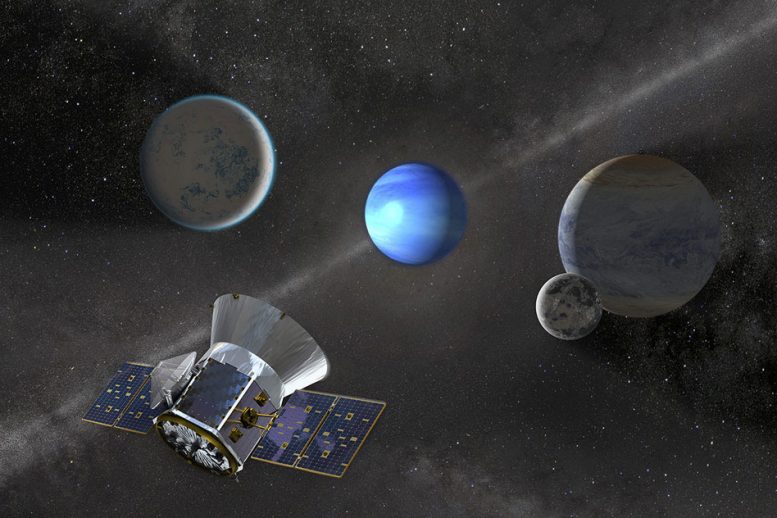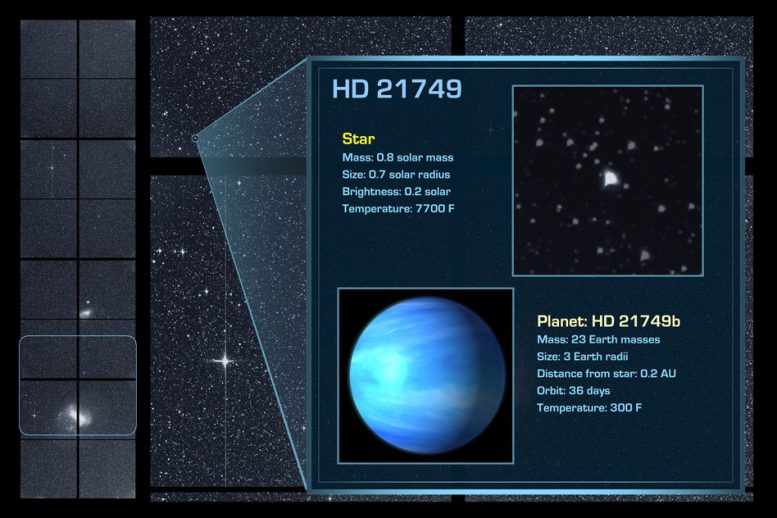Third Small Planet Outside Our Solar System

NASA’s TESS mission, which will survey the entire sky over the next two years, has already discovered three new exoplanets around nearby stars.
NASA’s Transiting Exoplanet Survey Satellite, TESS, has discovered a third small planet outside our solar system, scientists announced this week at the annual American Astronomical Society meeting in Seattle.
The new planet, named HD 21749b, orbits a bright, nearby dwarf star about 53 light years away, in the constellation Reticulum, and appears to have the longest orbital period of the three planets so far identified by TESS. HD 21749b journeys around its star in a relatively leisurely 36 days, compared to the two other planets — Pi Mensae b, a “super-Earth” with a 6.3-day orbit, and LHS 3844b, a rocky world that speeds around its star in just 11 hours. All three planets were discovered in the first three months of TESS observations.
The surface of the new planet is likely around 300 degrees Fahrenheit — relatively cool, given its proximity to its star, which is almost as bright as the sun.
“It’s the coolest small planet that we know of around a star this bright,” says Diana Dragomir, a postdoc in MIT’s Kavli Institute for Astrophysics and Space Research, who led the new discovery. “We know a lot about atmospheres of hot planets, but because it’s very hard to find small planets that orbit farther from their stars, and are therefore cooler, we haven’t been able to learn much about these smaller, cooler planets. But here we were lucky, and caught this one, and can now study it in more detail.”
The planet is about three times the size of Earth, which puts it in the category of a “sub-Neptune.” Surprisingly, it is also a whopping 23 times as massive as the Earth. But it is unlikely that the planet is rocky and therefore habitable; it’s more likely made of gas, of a kind that is much more dense than the atmospheres of either Neptune or Uranus.

Using the first three months of publicly available data from NASA’s TESS mission, scientists at MIT and elsewhere have confirmed a new planet, HD 21749b — the third small planet that TESS has so far discovered. HD 21749b orbits a star, about the size of the sun, 53 light years away.
“We think this planet wouldn’t be as gaseous as Neptune or Uranus, which are mostly hydrogen and really puffy,” Dragomir says. “The planet likely has a density of water, or a thick atmosphere.”
Serendipitously, the researchers have also detected evidence of a second planet, though not yet confirmed, in the same planetary system, with a shorter, 7.8-day orbit. If it is confirmed as a planet, it could be the first Earth-sized planet discovered by TESS.
In addition to presenting their results at the AAS meeting, the researchers have submitted a paper to Astrophysical Journal Letters.
“Something there”
Since it launched in April 2018, TESS, an MIT-led mission, has been monitoring the sky, sector by sector, for momentary dips in the light of about 200,000 nearby stars. Such dips likely represent a planet passing in front of that star.
The satellite trains its four onboard cameras on each sector for 27 days, taking in light from the stars in that particular segment before shifting to view the next one. Over its two-year mission, TESS will survey nearly the entire sky by monitoring and piecing together overlapping slices of the night sky. The satellite will spend the first year surveying the sky in the Southern Hemisphere, before swiveling around to take in the Northern Hemisphere sky.
The mission has released to the public all the data TESS has collected so far from the first three of the 13 sectors that it will monitor in the southern sky. For their new analysis, the researchers looked through this data, collected between July 25 and Oct. 14.
Within the sector 1 data, Dragomir identified a single transit, or dip, in the light from the star HD 21749. As the satellite only collects data from a sector for 27 days, it’s difficult to identify planets with orbits longer than that time period; by the time a planet passes around again, the satellite may have shifted to view another slice of the sky.


Comments
Post a Comment